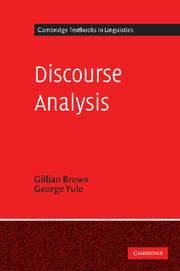Book contents
- Frontmatter
- Contents
- Preface
- Acknowledgements
- Transcription conventions
- 1 Introduction: linguistic forms and functions
- 2 The role of context in interpretation
- 3 Topic and the representation of discourse content
- 4 ‘Staging’ and the representation of discourse structure
- 5 Information structure
- 6 The nature of reference in text and in discourse
- 7 Coherence in the interpretation of discourse
- References
- Subject index
- Author index
2 - The role of context in interpretation
Published online by Cambridge University Press: 05 June 2012
- Frontmatter
- Contents
- Preface
- Acknowledgements
- Transcription conventions
- 1 Introduction: linguistic forms and functions
- 2 The role of context in interpretation
- 3 Topic and the representation of discourse content
- 4 ‘Staging’ and the representation of discourse structure
- 5 Information structure
- 6 The nature of reference in text and in discourse
- 7 Coherence in the interpretation of discourse
- References
- Subject index
- Author index
Summary
Pragmatics and discourse context
In Chapter 1, we emphasised that the discourse analyst necessarily takes a pragmatic approach to the study of language in use. Such an approach brings into consideration a number of issues which do not generally receive much attention in the formal linguist's description of sentential syntax and semantics. We noted, for example, that the discourse analyst has to take account of the context in which a piece of discourse occurs. Some of the most obvious linguistic elements which require contextual information for their interpretation are the deictic forms such as here, now, I, you, this and that. In order to interpret these elements in a piece of discourse, it is necessary to know (at least) who the speaker and hearer are, and the time and place of the production of the discourse. In this chapter we shall discuss these and other aspects of contextual description which are required in the analysis of discourse.
There are, however, other ways in which the discourse analyst's approach to linguistic data differs from that of the formal linguist and leads to a specialised use of certain terms. Because the analyst is investigating the use of language in context by a speaker / writer, he is more concerned with the relationship between the speaker and the utterance, on the particular occasion of use, than with the potential relationship of one sentence to another, regardless of their use.
- Type
- Chapter
- Information
- Discourse Analysis , pp. 27 - 67Publisher: Cambridge University PressPrint publication year: 1983
- 1
- Cited by



